
Wilson Combat Professional - Western Arms
Some people moan about WA's frequent revisitation of the 1911 model, but it seems the Japanese market cannot get enough 1911s and the Wilson Compacts, at least, offered me a first look at a compact 1911 model.

On closer look, they offered a lot more than a simple repackaging of the familiar 1911.
In the Box
As an SCW model (but not a limited edition), the Wilson Combat Tactical Supergrade Compact came in the familiar dark grey box with white SCW logos and a sticker down the side to let me know which particular model was inside.
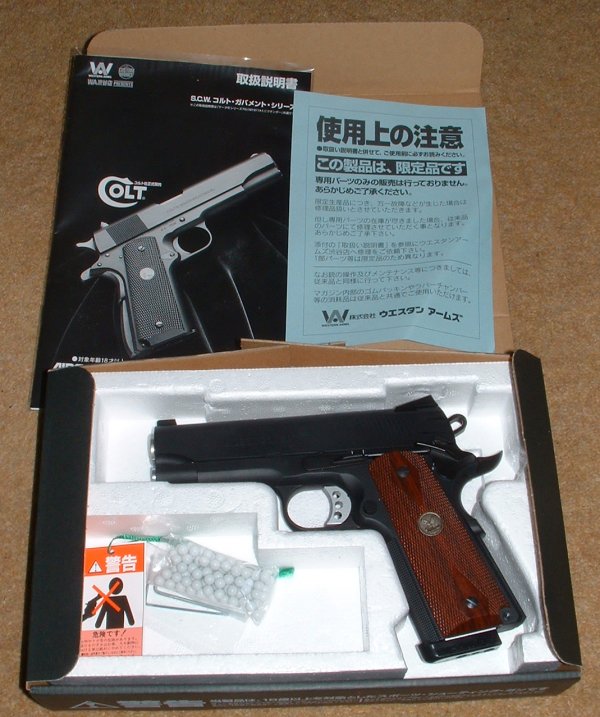
As well as the gun, the box contained the usual hopper, tube and rod loader, a bag of BBs, a couple of Allen keys (one for hop, the other for the trigger) and the usual collection of paperwork, including the standard SCW 1911 manual which seems to come with all 'single stacker' 1911s.
First Impressions
This gun differs from the similar, but Limited Edition, Tactical Compact in a number of small ways, but the first impression is of similarity.

Being small, the 850g weight makes the whole thing feel very solid and well made and there are no visible flaws in the finish, or seams, anywhere on the gun at first sight.
The grips look like rosewood, although (as usual) they are actually plastic, rather than the smart black and silver wood of the Tactical Compact.
Interestingly, up front the standard 1911 style bushing is absent, with a cone barrel, full length recoil spring rod and bushing-less assembly in its place, much like an SV Infinity.

Metal parts are pretty much as one has come to expect of a WA 1911, with trigger, slide lock, safeties (grip and thumb), front and rear safeties, outer barrel and recoil spring rod all being made in metal.
Closer Look
Whilst, basically a cut-down 1911, the Wilson Combat Professional has a number of unusual features.
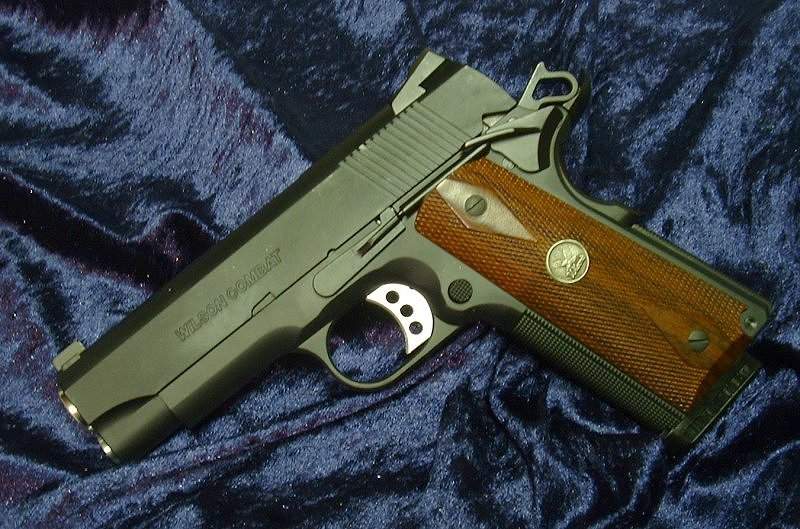
As you would expect, the Wilson is very well made and finished in the familiar heavyweight (ABS/metal mix) material, lending it an impressive heft despite overall dimensions around an inch less in length than a standard-size 1911.

Markings are nicely rendered, although not plentiful, true to the original. On the left side, the slide is marked "WILSON COMBAT" in a cut-out font, rather than the elegant script seen on some Wilsons. On the right, the slide is marked "PROFESSIONAL" in the same font.
On the frame, on the right side, there is "WILSON COMBAT BERRYVILLE AR. U.S.A." with "WA ASGK" just ahead, over the trigger. The magazine bumper is marked "WILSON COMBAT" on each side, upside down on the right side. The grips feature gold Wilson Combat medallions on each side.
The sights are fixed Novak style (But Wilson Combat marked) at the back with a dovetailed in blade at the front. In use, I found them, with white dots as standard, very easy to use and (as you will see later) effective.

The trigger is a broad silver blade, with three ridges for a secure purchase and three large holes to reduce its weight. It also has the travel adjustment (via a allen bolt in its face) as found on SVIs.
The barrel and chamber are silver in colour and the metal barrel has that slightly milled look which I have seen (and like) on a number of WA's most recent offerings (including the Expert 4.3" and Wilson Combat Profesional).
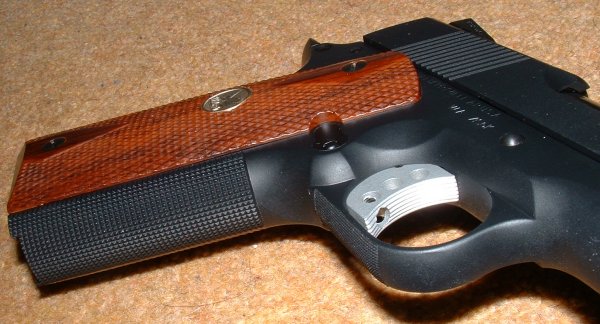
The magazine proved a pleasure and a pain. Sadly WA insisted, once again, on fitting the Wilson Combat bumper but failed to extend the valve beyond the base of the magazine. This means the valve is too deeply recessed to be reached by most gas can nozzles, which is only partly addressed by using a gas nozzle extension.
WA's choice not to simply extend the valve down close to the bottom of the bumper can only be on cost grounds (although I suspect they would point to the fact that a broken bumper will not also mean a broken fill valve, to be fair) and is, in my opinion, flawed.
However, the magazine is a full size 1911 magazine, unlike the Tactical Compact, where the buffer takes it out to the full 1911 grip length. Sadly, though this allows a capacity of only 15 BBs, as it lacks the new double stacking magazine design. There is, however, a small cutout in the front of the grip to accommodate the bumper.

The frame features chequering on the front of the grip and there is a flat mainspring cover, again with chequering.
The beavertail on the thumb safety is quite pronounced and there is only one a right handed thumb safety (not good for lefties, like me), whilst the hammer is skeletonised. All the controls, except the trigger, are painted flat black.
Shooting Impressions
The SCW compact 1911s offer an impressive shooting experience for such a small gun, with a snappy, strong kicking cycle and good accuracy and power.
I found the Wilson Combat Compact impressively accurate, too, so was expecting great things of the similar Professional.

Click on image for bigger version in separate window.
Carrying out my standard 5m/6 round, off hand test, with my first 6 shots I was able produce a best 5 grouping 2.75" inches (6.7 CMs) across.
However, these were arranged in a vertical line which seemed odd, so I decided to shoot another 6 shots.
This grouping was much more sensibly arranged grouping, in two tightly grouped bunches, both in the target centre. The best 5 grouping was 1.6 inches (4 CMs) across, which is pretty reasonable by any standards.
As with the Tactical Compact, what was really impressive was the ability of this compact gun to place all its shots in (or very close to) the target centre.
Over 10 shots, the Wilson Combat Professional averaged 243 fps (using Abbey Ultra gas and .2g BBs) indoors (at 12C).
| Shot | FPS |
| 1 | 252.5 |
| 2 | 246.5 |
| 3 | 245.3 |
| 4 | 238.9 |
| 5 | 232.4 |
| 6 | 251.3 |
| 7 | 245.5 |
| 8 | 240.5 |
| 9 | 240.0 |
| 10 | 245.9 |
Trigger pull is 26 Oz (740g), an impressively light pull for a GBB.
Take Down
As I have found with a number of recent WA guns, the slide lock on this example was very tightly secured in the frame from the box.
Unlike with the Tactical Compact, I persevered and managed to get it removed.
The disassembly process, however, is very much like any bushing less 1911 (for example WA's own SVIs).
With the magazine removed, the slide should be slide back until the slide lock can be pushed out of the frame. At this point, the slide, barrel and recoil rod/spring can be pushed forward off of the frame.
To remove the barrel from the slide, you must separate the two halves of the recoil rod and pull the front through the front of the slide bushing. I found this impossible, though, as (unlike on Infinities) the Compact doesn't have a hole through the rod to allow you to leverage the two halves with Allen Keys (as shown in the manual).
This done, however, the barrel front needs removing, too, at which point the rear half, barrel and chamber can be pushed back and down out of the slide.
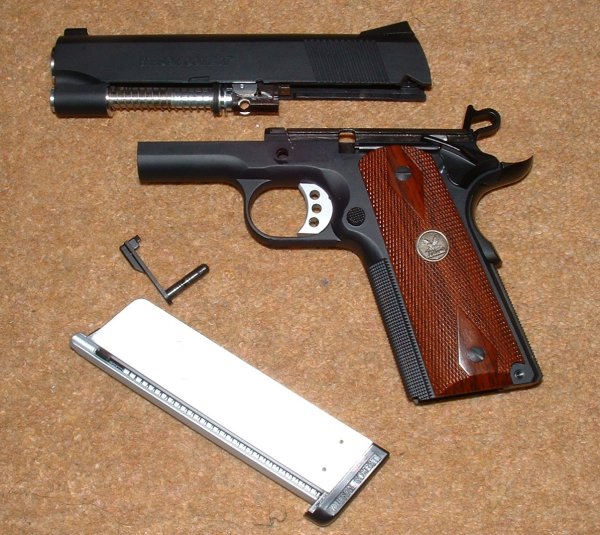
Conclusions
Overall, the Wilson Combat Professional is another excellent gun.
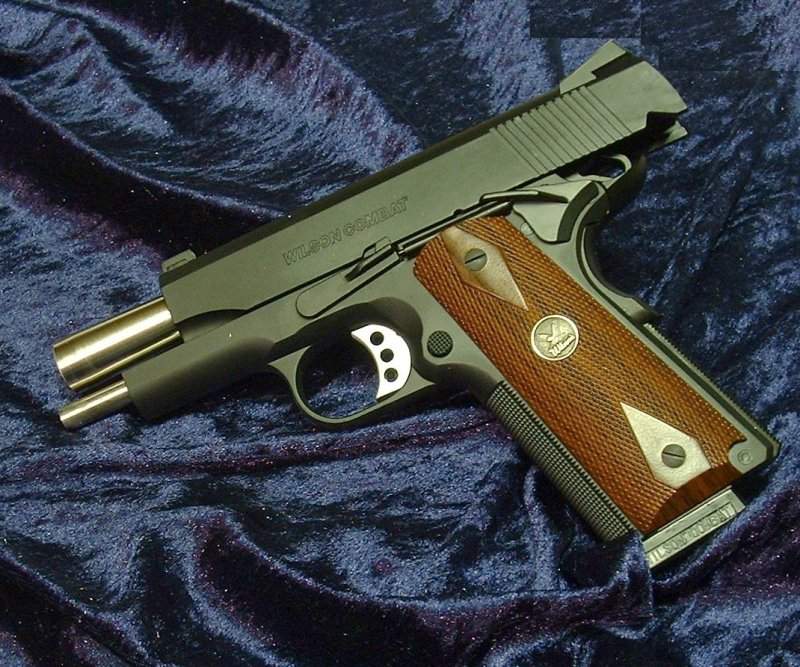
The SCW limited edition, Tactical Compact shades it, for me, by virtue of those lovely grips and that excellent double stacker magazine, but this model is generally available and offers all the shooting experience of the Tactical in an obtainable form!
Like so many of WA's guns, finding fault is hard and, as with most Wilson models, the biggest I can find is that troublesome magazine buffer which makes regassing such a pain.
For anyone looking for a quality, but compact airsoft GBB, the Wilson Combat Professional should be high on their list to consider.
Weight : 850g
Realism : ****
Quality : *****
Power : ****
Accuracy : ****
Buy this gun from Elite Airsoft
Back to the Homepage